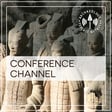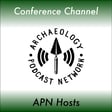Become a Creator today!Start creating today - Share your story with the world!
Start for free
00:00:00
00:00:01

065 - EAA2019 - Dr. Alexander Gramsch
These are selections of conversations recorded at the EAA2019 conference in Bern, Switzerland.
Dr. Alexander Gramsch works at the Römisch-Germanische Kommission in Frankfuhrt. Tristan spoke to him at the RGK table in the upstarirs section of the University of Bern, the Kuppelraum. Dr. Gramsch explains the work of the RGK and talks about the benefits and challenges of using digital microscopes.
To find out more info please check out :https://journals.ub.uni-heidelberg.de/index.php/germania/index
Recommended
Transcript
Introduction to Archaeology Podcast Network
00:00:00
Speaker
You're listening to the Archaeology Podcast Network.
Guest Introduction: Alexander Grams
00:00:05
Speaker
I'm Alexander Grams from Rheumuschka Management Commission in Frankfurt. Wonderful, wonderful. And you've got a stall up here in the Kuppelram. So can you tell me what the
Overview of Research Institute's Departments
00:00:16
Speaker
stall is? Can you describe it to our listeners?
00:00:18
Speaker
Well, this doll is presenting the different departments we have and the different services we offer as a research institute in archaeology. So what we do have is a large editorial department with several book series and two journals and we have a large technical department which now is called
00:00:40
Speaker
the Department of Survey and Excavation Technology and we're involved in several international and EU-wide research projects and that's the stuff we want to convey to our visitors.
New Approaches to Bioarchaeology
00:00:56
Speaker
Excellent, but you were also presenting as well, so what was a session you were doing or what was your presentation about?
00:01:02
Speaker
Yeah, I was contributed to one session, which was yesterday, and the session with the title, New Approaches to Bioarchaeology. I myself am a proper archaeologist, so not an anthropologist or bioarchologist, but I'm cooperating with a physical anthropologist and we're doing research on traces of manipulations on human bones.
3D Bone Manipulation Documentation
00:01:26
Speaker
And the thing that we are currently doing is using a digital microscope that we have at the Grzemyszka Management Commission in Frankfurt to see how we can document this in 3D. The advantage of a digital microscope is that you can have assembled 3D pictures where
00:01:48
Speaker
But all areas are equally sharp. There's no blurred areas. Even if you have a skull where the cut marks may be round. And so the idea behind it is to have a powerful research tool and a good concept about what manipulation traces, perimortal traces may mean on bodies.
Challenges with Digital Microscopy
00:02:14
Speaker
actions, practices that have been performed on bodies at the period when a person died and was transformed into somebody else. And obviously with new technology, always there's new challenges as well. What are the challenges with using a digital microscope?
00:02:32
Speaker
It takes a lot of time to get the experience of how really to record your cut marks. Many of them are visible to the plain eye. And you could use a simple microscope or just a magnifying glass to see them more clearly. But if you want to get down to the details and really to see the gesture of performing like removing flesh from the bone, for example, or removing the scalp from the skull,
Conclusion and Call to Action
00:03:03
Speaker
You have to figure out a work process, where to start and how to use this machine to move from one end of this cut that you see to the other to get this unblurged, to get this clear picture. Thank you very much.
00:03:17
Speaker
This has been a presentation of the Archaeology Podcast Network. Visit us on the web for show notes and other podcasts at www.archpodnet.com. Contact us at chrisatarchaeologypodcastnetwork.com.

